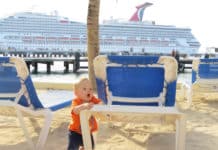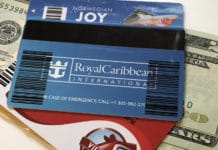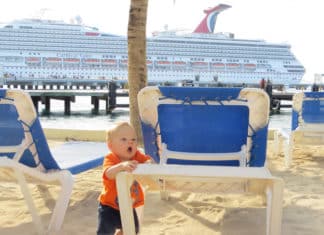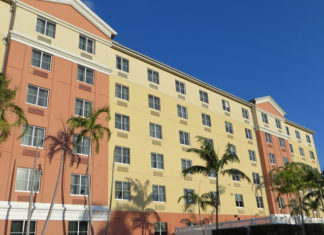If you have a disability, then it doesn’t mean that you can’t enjoy the experience of vacationing on a cruise ship. In fact, cruising is a great way to get out and see the world, especially since the cruise lines are extremely conscious about making the accommodations needed for passengers with disabilities.

In fact, given the control that cruise lines have over the building of and the services offered on their ships, it’s hard to beat a cruise when it comes to accessibility. Unlike a resort that could have been built decades ago — before accessibility was a major consideration — cruise ships are relatively modern. That means they can offer ease and comfort not often seen in other venues.
However, we know that having a disability means you have to consider how you’ll perform day-to-day activities that most people take for granted — especially when going into an unfamiliar place like a cruise ship. To help you out, we’ve researched the major cruise lines to bring you everything we can about accessibility issues.
Fortunately, cruising is among the most accommodating ways to travel. Even so, there are some things you should know.
Keep in mind that the information below is general. If you have specific questions not answered, it’s best to contact the cruise line directly. We’ve included contact information at the end of the article.
In This Article...
Getting Around the Ship
As we mentioned above, cruise lines have come a long way in making their ships accessible. Whether it be modified elevators to lowered Guest Services desks, there has been a lot of effort put into making the ships more friendly for passengers with disabilities.
In general, guests in wheelchairs or scooters should have no problem getting nearly everywhere on the ship.
You’ll find that many cruise liners have automatic doorways when accessing public decks — especially in the high-traffic corridors. Ships are also equipped with banks of elevators to get you from deck to deck.
If mobility issues are extremely important to you, then you’ll appreciate Carnival’s page on the topic. This page includes different deck plans that identify all of the accessible routes through each ship, along with cabins and restrooms that are accessible. It also shows how serious cruise lines take accessibility.
Keep in mind that public areas are also made to accommodate those with disabilities. For example, Royal Caribbean offers lifts for at least one pool and one hot tub on board each ship in its fleet. The cruise line also offers lowered playing tables and slot machines in the casino. Carnival offers pool lifts on a handful of its newest ships.
Of course, even on the biggest cruise ships space can sometimes be tight. However, in general ships (especially newer ones) are made with mobility issues in mind.
Wheelchairs and Scooters on a Cruise Ship
If you have trouble walking long distances, you may want a wheelchair. The major cruise lines are happy to provide you a chair during boarding and debarking, however, you must bring your own chair or scooter if you’d like one during your entire cruise.
Note: If you’d like a chair or scooter during the cruise but don’t already own one, you can rent one from the following companies:
Scootaround
Phone 1-888-441-7575
E-mail: info@scootaround.com
Special Needs at Sea
Phone: 800-513-4515
E-mail: info@specialneedsgroup.com
One important rule about chairs and scooters is that they should ideally be (or fold) to less than 21″ wide. That limit is so that they can fit within your cabin. Cruise lines don’t allow the devices to be stored in hallways as they impede the walkway, creating a danger in case of emergency. If your device is larger, don’t panic, it’s still allowed. It’s just better if they can be stowed in a smaller space.
Accessible Cabins

Accessible cabins onboard cruise ships are significantly larger than most standard rooms, and filled with features to make getting around easier. For instance, while most cabin doorways are around 23″ wide, accessible rooms have doors that are 32″ wide.
The cruise lines have designed these cabins to be accessible, even in a small space. For example, here are all the features on Royal Caribbean’s ships in its accessible staterooms:
• Available on all ships in a variety of categories
• Stateroom and bathroom door width: at least 32 inches
• Automatic stateroom doors on Radiance/Quantum-class ships
• No stateroom doorway threshold
• Lowered closet rods and safes
• Lowered sink and vanity
• Ramped bathroom doorway thresholds
• Roll-in showers with grab bars
• Fold-down shower seat and hand-held shower head
• Raised toilet seats – most are between 17 to 19 inches high
• 5-foot turning radius in sleeping, sitting and bathroom areas
• Accessible balconies
• Most located near elevators
One thing to keep in mind that the accessible staterooms are limited. For reference, Royal Caribbean’s Quantum of the Seas (one of its largest ships) has roughly 35 handicapped-accessible cabins. Therefore, if you know you’ll need one of these rooms and aren’t flexible with dates, be sure to book your cruise early for the best selection.
See the video below for a quick video tour of an example accessible cabin.
Ports of Call
It’s likely that your cruise ship can cover just about any special need you might have for any disability. However, ports of call are a different story.
In general, you’ll likely find that most ports of call have at least some difficulties for those with handicaps. From uneven streets to few facilities for those with a disability, many ports of call just aren’t well setup for people with special needs. That’s not to say you can’t go enjoy yourself. It’s just simply more of a challenge than life on the ship.
That’s not the case everywhere, however. Many ports like Cozumel or Costa Maya have large port areas that are designed specifically to cater to cruise ship passengers. In these modern areas, many of the accommodations (e.g. sloped areas for wheelchairs, accessible bathrooms) are available. Once outside of the port area, however, the story is different.
If your cruise is stopping at a cruise line’s private island, then you’re in luck. Think of these islands as extensions of the ship. They are designed with accessibility in mind. This includes everything from beach wheelchairs to smooth pathways to transportation services to get those with mobility issues around the island, as well as accessible facilities. In short, if you have a disability, then booking an excursion with a private island included is a good idea.
Piers/Tender Boats
One other thing to consider is how you’ll actually get into a port. Most ports have piers. The ship docks alongside and passengers simply get out and head into port. But a handful of stops like Norwegian Cruise Line’s Great Stirrup Cay and Belize City use tenders to get to port.
When using a tender, passengers head from the ship onto a small boat to head into port. For those with mobility issues or wheelchairs, this can be more of a challenge, especially if the water is choppy.
Shore Excursions

Part of the fun of going on a cruise is getting off the ship in port and going on excursions. Of course, not every excursion is going to be able to cater to disabled guests, but the wide mix of activities mean there is something for everyone.
When looking for excursions, all the cruise lines will have descriptions of the tour and some notes about how strenuous it is for guests. Often they will include a handicap symbol if an excursion is accessible. If not, don’t simply take that to mean it isn’t appropriate for someone in a wheelchair. We’d suggest going to talk with the excursion booking staff once on the ship. They will know firsthand what is available, depending on your mobility.
Service Animals on a Cruise
In most cases, passengers can bring service animals on board the ship, but keep in mind there are a number of restrictions.
First and foremost, a service animal is defined as an animal that is specially trained to help with a disability-related need. The cruise lines go out of their way to clarify that service animals are not pets, nor are they “therapy animals” or even service dogs in training.
Service animals must have proof of all current vaccinations for the cruise line, but that’s not all. In addition, passengers must find out on their own which vaccinations for animals are required for each port country. If they fail to have proof of these shots, then it’s likely the animal won’t be allowed to disembark.
For more details on traveling abroad with a service dog, you can check the USDA’s page on the topic: https://www.aphis.usda.gov/aphis/pet-travel
You’ll want to contact your specific cruise line for full details and any particular questions you might have about access to areas of the ship with a service animal. In general, the cruise lines refuse to supply food or provide care to the animal. So if you want to go ashore without the animal, don’t expect them to walk or toilet them in your absence.
If you are traveling with a service dog, you’ll want to get in touch with the cruise line well in advance to alert them of the need. They can walk you through any special requirement or specific questions you might have. Most lines can even offer a “relief area” for the animal to use the restroom on the ship.
Prescriptions on a Cruise

Nothing can make a person feel more uncomfortable than bringing loads of medication through a security checkpoint. There is just something about carrying pills that feels like you are asking for trouble. The good news is that cruise lines, which often cater to older crowds, are used to seeing people bringing medications in large quantities.
The best idea is to bring your prescriptions in their original bottles. That way there is no trouble identifying pills, and your pharmacy contact information is right on the bottle should anyone question the prescription. In practice, medication rarely causes a problem.
It is smart to always carry your medication in your carry-on luggage. If you need access, your prescription will always be right by your side.
Diet Needs & Food Allergies
One of the biggest perks of cruising is the food. Of course, if you have special diet needs, it might also be an area that causes some worry. It shouldn’t.
Today’s cruise lines can be extremely accommodative for your diet needs. For example, Carnival boasts that they can “can provide our guests with the following special dietary needs: vegetarian, low-cholesterol, low-fat, low-carbohydrates, low-sugar and gluten free.”
For most diet needs, you don’t even need to alert the cruise line ahead of time. The best thing to do is go to the dining room and let your main dining room waiter know of your needs. They can help answer questions and offer suggestions for meals based on your restrictions. For meals outside of the main dining room, you will have to be vigilant and let the staff know of your needs.
If you have a restrictive diet, it’s a good idea to let the cruise line know at least two weeks before you sail so they can prepare. The good news is that modern cruising can cover just about any restriction you have.
One other thing to note is that you are allowed to bring pre-packaged foods and snacks with you onto the ship. They can’t be homemade and they must be sealed in their original package.
Hearing Impairment
Cruise lines are especially knowledgeable about helping passengers with hearing difficulties. Most cruise lines offer room kits that include visual/tactile alerts for telephones, alarm clocks and door knocking. In addition, a TTY can be placed within your stateroom that connects with the front desk in order to communicate with guest relations.
Other features for those with hearing issues include:
- Amplified telephones around the ship
- Assistive hearing headsets for use in ship theaters
- Closed-captioned televisions across fleets
- Sign language interpreting services in places like theaters, presentations, and major events. Guests should contact the cruise line well in advance (90+ days in some cases) to ask for this service if required.
Vision Impairment
Today’s modern cruise ships all come equipped with braille signage throughout the ship. This includes elevators and stateroom signs. As well, many cruise lines will offer orientation tours of the ship and large-form menus. If you have a service dog to help you with vision impairment, be sure to see our section above on service animals.
Cruising with Children with Disabilities
If you have a child with disabilities, cruises are a great vacation choice. Not only are there plenty of opportunities to have fun as a family, but there are also opportunities for respite while on your trip.
Major cruise lines have youth programs where children of all abilities are welcome. The cruise lines usually separate the kids by age (since 5-year-olds want to different things than 14-year-olds), however, if a child has special needs, they will group a child by their ability level.
The rule of thumb is that staff can’t provide specialized attention. That means they can’t help a child take medication, feed them, nor can they offer one-on-one supervision under most circumstances. If this is the case, either the parent or helper can stay with a child.
Cruise lines will give parents pagers/phones to give them piece of mind. If a parent is needed, the pager will alert them aboard the ship.
Tips for Cruising with a Disability
Obviously, there’s a lot to consider when cruising with a disability, but the good news is that cruise lines are extremely accommodating. If you want some of our top tips for making your vacation better, consider the following.
Sail Newer Ships
All cruise ships will have accommodations designed for those with disabilities. That said, we’d suggest sticking with the newest ships you can. Newer ships will have the latest features (including things like automatic door openers for accessible cabins on some ships), but most of all, new ships can offer more space. Newer ships are built larger than their predecessors, providing more ease of movement throughout.
Book Your Cruise Early
While cruise lines go out of their way to offer accessible features, they are limited in the number of accessible cabins on the ship. And once they are gone, they are gone. For that reason, it’s a good idea to book your cruise as early as possible if you need an accessible cabin. This will give you the most options possible for your schedule.
Contact The Cruise Line Soon
If you are sailing and have special needs, then it’s a smart idea to call the cruise line as soon as possible to discuss any accommodations you might need. For instance, those needing a sign language interpreter (which are available) need to give 60-90 days notice before they sail. It’s also a good chance to get any questions you might have answered well before you head to the port.
Contacting the Cruise Lines
If you have special needs or a disability that you think requires special consideration, the best thing to do is contact the cruise line well in advance of your sail date. By contacting them, not only can they answer any questions, but they can also prepare accommodations to make your cruise more comfortable.
Depending on which cruise line you sail, we recommend the contacts below.
- Royal Caribbean: Special_Needs@rccl.com | 866-592-7225 | Special Needs Form
- Carnival: access@carnival.com | 800-438-6744, ext. 70025
- Norwegian Cruise Lines: 866-584-9756
- Disney: SpecialServices@disneycruise.com | 407-566-3602
- Celebrity: special_needs@celebrity.com | 954-628-9708
- Princess: 800-774-6237
The following websites can offer more details about the accommodations for specific cruise lines:
Royal Caribbean
https://www.royalcaribbean.com/experience/accessible-cruising
Carnival
https://www.carnival.com/about-carnival/special-needs.aspx
Disney
https://disneycruise.disney.go.com/guest-services/guests-with-disabilities/
Norwegian Cruise Lines
https://www.ncl.com/about/accessible-cruising
Celebrity
https://www.celebritycruises.com/special-needs
Princess
https://www.princess.com/learn/faq_answer/pre_cruise/prepare.jsp#Passengers_Special_Needs













Im an adult who’s disabled.i want to go on a cruise ship for the 1st time I hear the ship has activities that the disabled can do. What are the activities, what us the Ed layout of the room etc. Any advice we’re all ears
It’s actually difficult to list everything here. During the day there are dozens of things that go on — contests, dancing, shows, eating, etc. Apart from a few of the more active items (such as rock-climbing or something similar) just about everything can be enjoyed by anyone.
Holland America on some vessels have scooters or wheelchairs you can rent onboard for uour cruise. I rented on the Noordam this past September. Made excursions into port so much better.